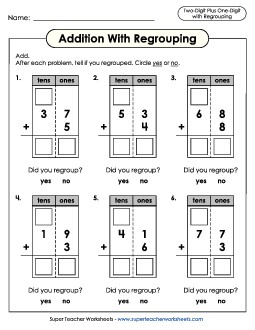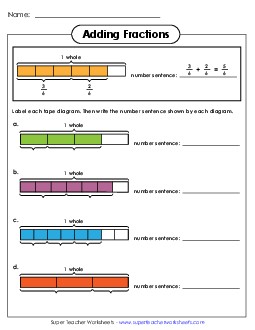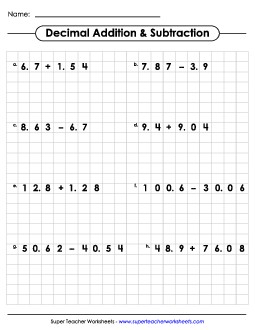Multi-Digit Addition

The addition worksheets on this page have no regrouping or carrying.
Approx. levels: 1st grade, 2nd grade
The double-digit addition worksheets on this page include free offerings and require students to carry ones, or regroup. Includes graph paper math, a Scoot! game, and word problem worksheets.
Approx. levels: 1st grade, 2nd grade
These printable worksheets and games have addition problems with 3-digit addends. Includes math riddles, a magic digit game, math crossword puzzles, and column addition worksheets.
Approx. Level: 2nd grade, 3rd Grade
This page has resources for teaching addition with 4-digit addends. Activities on this page include: column addition exercises, an addition crossword, task cards, and word problems.
Approx. level: 3rd grade, 4th grade
Use these printable resources to learn, review, and practice addition with 5-digit addends.
Approx. level: 4th grade, 5th grade
When you print these activities, you'll notice that the problems have 3, 4, or 5 addends. Includes 1, 2, 3, and 4-digit numbers.
Adding 10 and Multiples of 10This page has free task cards and worksheets for teaching students to add 10 or a multiple of 10 to any 2-digit number.
Fraction AdditionOn these worksheets, students will practice adding fractions and mixed numbers. Includes fractions with same denominator and different denominators.
Approx. levels: 3rd, 4th, 5th, and 6th grades
Find sums and differences for pairs of decimals on these worksheets. These practice pages have free printables to practice decimals in tenths, hundredths, and thousandths.
Money AdditionThese printables have horizontal and vertical money addition problems, as well as word problems.
Integer Addition & Subtraction(Positive and Negative Numbers)
Practice finding sums and differences of positive and negative integers.
Properties of AdditionLearn about the commutative and associative properties of addition with these printables.
Approx. levels: 3rd, 4th, 5th
These basic addition problems have addends up to 5 and sums up to 10. Includes puzzles, practice worksheets, card games, illustrated concept sheets, and more. (examples: 4+1=5, 2+3=5)
Approx. level: Kindergarten and 1st Grades
This page has lots of activities to use when teaching basic addition facts. Includes a memory match game, dice games, bingo, drill worksheets, flashcards, number line practice, and much more. All facts have addends between 0 and 10. (examples: 9+8=17, 8+6=14)
Approx. levels: 1st and 2nd grades
The worksheets you'll find here have a mix of basic addition and subtraction on them.
Approx. grade: Kindergarten, 1st grade, 2nd grade
These worksheets and activities will help students discover pairs of addends with sums of 10.
Basic Addition: Doubles FactsLearn basic addition doubles facts. These are addition problems in which you add a number to itself.
(examples: 3+3=6, 5+5=10, 7+7=10)
The worksheets on this page can be used to teach students to solve doubles +1 facts. These are addition problems where students double a number, then add one.
(examples: 2+3=5, 5+6=11, 8+9=17)
This section has several worksheets for teaching fact families. (Also known as number bonds or number families.) Approx. levels: 1st and 2nd grades
Sum GameThis page has many different versions of STW's Addition Sum Game. In this game, students take turns circling pairs of numbers that add up to a given amount. For example, they might search for pairs of numbers that add up to 17.
Approx. level: Grade 1, Grade 2, Grade 3
Can your students solve these tricky logic puzzles? There are three levels: basic, intermediate, and advanced.
Math Riddle WorksheetsThere are many addition worksheets on our Math Riddle page too. On these sheets, students can decode the answer to a funny riddle by completing arithmetic problems.
Math Mystery PicturesThis section of the site links to many basic, single-digit addition worksheets. Students solve addition problems, then color the mystery picture according to the color-coded key at the bottom of the page.
Multiple Step Word ProblemsStudents use addition, subtraction, multiplication, and/or division to solve these multi-step math word problems.
Using Number LinesLearn to add and subtract with number lines.



Super Teacher Worksheets knows that advanced addition is a critical topic in elementary school math that builds on the foundational skills of basic addition. Typically taught in second through fifth grades, this topic covers multi-digit addition, fraction addition, and decimal addition, each of which plays a vital role in a student’s overall mathematical development. Multi-digit addition involves combining numbers with two or more digits, requiring students to understand concepts like carrying over (regrouping) and place value. As students progress, they also learn to add fractions with like and unlike denominators, as well as decimals, which are essential for more complex mathematical operations and real-world applications.
In the classroom, teachers use a variety of methods to help students master these advanced addition skills. For multi-digit addition, tools like place value charts, base ten blocks, and interactive whiteboard activities help students visualize and practice the regrouping process. Fraction addition is often taught using visual aids like fraction bars or circles, which allow students to see how fractions combine to form a whole. For decimal addition, number lines and place value grids are effective in helping students align decimals correctly and understand the importance of precision. Teachers also use word problems and real-world scenarios to contextualize these skills, showing students how advanced addition applies to everyday tasks like measuring ingredients, calculating totals, and handling money.
Understanding advanced addition is crucial for students as it underpins much of the math they will encounter in later grades and in daily life. Whether they are solving complex word problems, working with algebraic equations, or managing finances, a strong grasp of addition is essential. Proficiency in multi-digit, fraction, and decimal addition also helps students develop logical thinking and problem-solving skills, which are important for success in both academics and real-world situations. By mastering these advanced addition techniques with the help of Super Teacher, students gain confidence in their math abilities and build a solid foundation for future learning.






